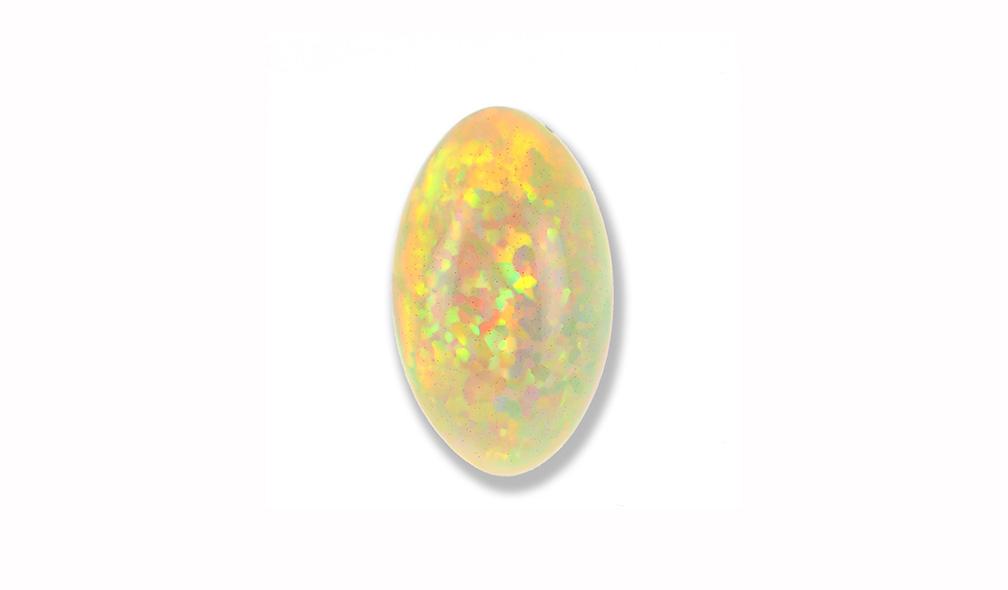
Cinnabar Inclusions in Ethiopian Opal
The authors recently examined a 15.8 ct Ethiopian opal (cover picture) that contained numerous red dendritic particles (Figure 1) that each measured about up to 70-100 µm in diameter (Figure 2). The Ethiopian origin was confirmed by its physical (slightly hydrophane, size of the red patches and rounded columnar structure) and chemical characteristics (high Ba concentration; Rondeau et al. 2010). The inclusions were identified by Raman micro-spectroscopy as cinnabar (HgS). EDXRF chemical analyses of the top surface of the sample confirmed the presence of Hg and S. Cinnabar and opal are associated in numerous localities, particularly in the western USA (Knopf 1915; Gettens et al. 1972; https://www.mindat.org/min-3004.html). However, cinnabar is only rarely mentioned as inclusions in opal (see, e.g., Gaillou 2015). Also known is opalised or silicified cinnabar material known as myrickite, in which the high concentration of cinnabar inclusions induces an intense orange or red colour (Manutchehr-Danai 2009; Melero et al. 2019).


To the authors’ knowledge, this is the first time that cinnabar inclusions have been documented in opal from Ethiopia. Their dendritic habit suggests relatively fast growth, whereas magnetite inclusions reported in Ethiopian opal have a well-formed octahedral habit (Rondeau et al. 2010), suggesting slow growth. This points to a vast domain of parameters possible (at least in terms of growth rate and chemistry) for the formation of inclusions in Ethiopian opal, which perhaps reflects the vast region over which those deposits occur.
Authors
- Féodor Blumentritt, GGTL Laboratories Switzerland, Genève, Suisse. ResearchGate.
- Candice Caplan, GGTL Laboratories Switzerland, Genève, Suisse. ResearchGate.
- Emmanuel Fritsch, IMN-CNRS et Université de Nantes, France. ResearchGate
- Franck Notari, GGTL Laboratories Switzerland, Genève, Suisse. ResearchGate
References
- Gaillou, E. 2015. An overview of gem opals: From the geology to color and microstructure. Thirteenth Annual Sinkankas Symposium—Opal, Carlsbad, California, USA, 18 April, 10–19.
- Gettens, R.J., Feller, R.L. & Chase, W.T. 1972. Vermilion and cinnabar. Studies in Conservation, 17(2), 45–69, https://doi.org/10.2307/1505572.
- Knopf, A. 1915. Some cinnabar deposits in western Nevada. Contributions to Economic Geology, Part I, Metals and Nonmetals Except Fuels, 59–68, https://pubs.usgs.gov/bul/0620d/report.pdf.
- Manutchehr-Danai, M. 2009. Dictionary of Gems and Gemology. Springer, Berlin and Heidelberg, Germany, 1,037 pp., https://doi.org/10.1007/978-3-540-72816-0.
- Melero, D., Lobato, B., López-Antón, M.A. & Martínez-Tarazona, M.R. 2019. Identification of mercury species in minerals with different matrices and impurities by thermal desorption technique. Environmental Science and Pollution Research, 26(11), 10867–10874, https://doi.org/10.1007/s11356-019-04245-8.
- Rondeau, B., Fritsch, E., Mazzero, F., Gauthier, J.-P., Cenki-Tok, B., Bekele, E. & Gaillou, E. 2010. Play-of-color opal from Wegel Tena, Wollo Province, Ethiopia. Gems & Gemology, 46(2), 90–105, https://doi.org/10.5741/gems.46.2.90.
© The Gemmological Association of Great Britain. This article was published in "The Journal of Gemmology". (2022), Volume 38, Issue 3, pp 217-219.
